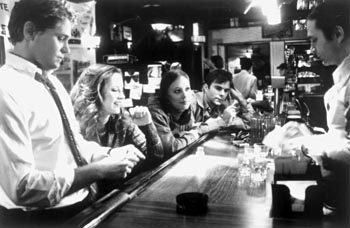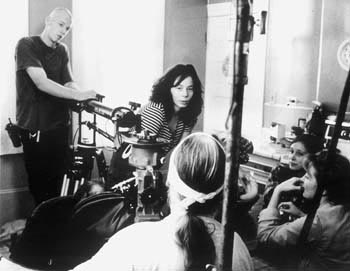Girls on Film
The director and star of 'Whatever' chat about bad sex and good movies
By Michelle Goldberg
A DRUNKEN GIRL lies half-conscious in a grassy field while some jocular boys have sex with her. One of them holds her head, soothes her and pours more liquor down her throat. When they're finished with her, the boys walk away, chuckling and jostling each other, to join a party below, leaving the girl half-naked and alone.
The first few frames of Susan Skoog's debut film, Whatever, plunge us into the casually barbaric, sexually brutal world of a suburban high school. But Whatever isn't a titillating teen-sex shocker like Kids. Soon after the gang sex, the girl's best friend rides up on a bicycle and rescues her, and the film's intensity comes as much from the girls' bond as from the banal horrors that surround them.
Whatever is one of the frankest films ever made about teenage girls, with all their symbiotic friendships, passionate ambitions, awkward sexual fumbling and drug-fueled revelations.
Set in New Jersey in 1981, Whatever follows unlikely best pals Anna (Liza Weil) and Brenda (Chad Morgan) as they skip school, run around Manhattan, snort coke with older guys and take care of each other as well as they can before eventually growing apart. Anna is spunky and smart, with dreams of studying painting. Brenda is gorgeous, wild and ready to run away from her abusive stepfather with the first guy who comes along.
Unlike Sarah Jacobson's acclaimed first feature, Mary Jane's Not a Virgin Anymore, in which the feisty high school heroine learns to masturbate and demand gratification from her lovers, Whatever is not about sexual awakening. Skoog's real themes are sexual powerlessness and confusion.
Whatever's cautionary attitude toward sex may seem reactionary in an age when pro-porn writers Susie Bright and Camille Paglia have surpassed Gloria Steinem as feminist mouthpieces. But although Whatever may not be as empowering as Jacobson's film, it seems more representative of most girls' real lives.
MUCH OF THE REASON that Whatever feels so honest is the combination of empathy and insight provided by Skoog, 33, who used her life savings and $30,000 in credit to make the film. But the movie wouldn't ring nearly as true as it does without the funny, raw, searching performance of 21-year-old Weil as Anna.
Now that Sony has picked up Whatever for distribution, the company has sent Weil and Skoog on an international tour. I met them in San Francisco's Sheraton Palace hotel, where they talked about independent filmmaking, bad sex and the '80s over cigarettes and cappuccino.
Skoog grew up in New Jersey, went to high school in the '80s and longed to escape to Manhattan, but she says that Whatever isn't autobiographical. "Anna was a lot cooler than I was. Liza and I both say that," she explains. "None of the events that happen in the film really ever happened to me, but a lot of it was stuff that happened to people I knew. There's about 10 people in Anna and Brenda."
Nowadays, mainstream magazines like Jane run features on the pros and cons of orgies, and Bright, in her advice column in Bust magazine, tells a 13-year-old girl that she's not too young to have sex. So it's hard to talk about how awful sex can be when you're young without sounding like a women's studies major on her first "take back the night" march.
That's why Whatever is so important. Anna must navigate a sexually rapacious world, but she has so much self-possession that she never comes across as a victim. Whatever captures the way teenage amorous encounters go from flushed excitement to fearful embarrassment to deadly boredom--all in the time it takes some overeager guy to yank his fly down.
"Teenage sex, most of the time, especially for girls, is not anywhere near as romantic as we want to think it is," Skoog says. "I wasn't trying to be depressing, but I was trying to show the warts of life. You get twisted and hung up if you don't talk about this stuff. You don't realize that you're not abnormal just because you didn't like sex for the first 10 years. The first couple times you have sex, if it's bad and you get drunk to do it--well, girls do that. A lot of girls do that. But they lie about it--Anna lies about it--because girls think they're supposed to like it, and you can't even tell your friends that no, it didn't feel very good."
Importantly, though, Whatever is about more than the unhappy consequences of teenage risk-taking; there are also moments of giddy joy and conspiratorial excitement. There's a wonderful sequence in which Brenda and Anna cut school, dress up and go to New York City. They run around Washington Square Park and lie to everyone they meet, telling people that Anna is a famous artist, pretending they're the people they want to become. It's the good side of being bad girls: the freedom, the us-against-the-world bonding.
FROM AN ADULT perspective, it can be hard to see why shy, serious Anna and brassy, licentious Brenda would be friends, but Skoog understands the random nature of childhood bonds.
"When you're that age, your friends are from proximity," she says. "You grew up near each other, and you just stay friends. Then, when you get to be about 17, you're like, wait, why are we friends? We don't relate, we're totally different, but she's your best friend, and you're very intimate. Part of what I was trying to chronicle in this film is the demise of these two girls' relationship, how they're growing away from each other. That was something I thought was really interesting."
Indeed, what teen-angst auteurs like John Hughes never understood was that the most intense romance in most girls' lives isn't with the boy they take to the prom, it's with their best friend. In the past few years, there has been a rash of films about girlhood sexual turmoil--Mary Jane's Not a Virgin Anymore, Heavenly Creatures, All Over Me, Ripe, Girls Town--as well as an explosion of music and zines determined to tell the thrilling, awful truth about teenage females.
Why now? "Women are coming of age to make films," Skoog says. "Things are more equal for women now; there's more opportunity; and people are more accepting. I'm 33, and I think a lot of women making these films are in their late 20s or early 30s. They're just coming of age to the point where they're able to make films about their own experiences and with their own sensibilities."
The coming of age of Skoog's generation also likely accounts for the recent wave of '80s nostalgia films like The Wedding Singer, The Last Days of Disco and Grosse Pointe Blank.
"I made the movie and set it in the '80s because that's when I was in school, and I thought it would be fun to sort of look back," Skoog explains. "It's an interesting little window of time before AIDS and before 'Just Say No' and all that. It was actually easier [to set the film in the past], because we got a lot of the clothing from thrift stores, and people gave us their old stuff for set decorating."
Skoog nails the suburban-rocker aesthetic of the '80s without turning it into a distracting parody. Twenty minutes into the film, you forget that the characters are decked out in off-the-shoulder shirts, feathered hair and unironic blue eye shadow.
The entire cast had a hand in re- creating the period, even though Weil was only six years old in 1981. "We would go to thrift stores with the wardrobe department and pick stuff out that we thought our characters would wear," Weil recalls. "If production design was going to put a poster in our room, and we didn't think it should go there, then they'd get rid of it and put something else up. Everybody was pretty much on the same page."
Weil says that because she had such a hand in fleshing out Anna's character, it took a long time to get out of character after the film was finished. "There are definitely bits of Anna that I wish I could be like," she explains. "She's the freshest girl on the block. But a lot of it was there in the writing. The casting was so well done that everybody started relating to each other in character all the time. It was really a weird experience that way, because it took us a long time to get out of that whole mode."
The parts of Anna that Weil relates to include "wanting to get out of your surroundings and make something of yourself but being scared that you're not going to be able to do it, that you're not good enough. Anna pretty much represents everygirl, U.S.A."
It would be nice to think that 17 years later, everygirl, U.S.A., has moved beyond Anna's and Brenda's predicaments--after all, isn't that what fierce girl power was supposed to be about? But a world full of absent or abusive parents and ugly, barren suburbs has left teenagers bored and adrift. Growing up female is still so hard that the stories and characters in Whatever don't feel at all obsolete.
[ San Jose | Metroactive Central | Archives ]
Copyright © Metro Publishing Inc. Maintained by Boulevards New Media.
![]()

Studying for the Bar: Best friends Brenda (Chad Morgan, left) and Anna (Liza Weil) spend a night out on the town in Susan Skoog's 'Whatever.'
John Hughes She's Not: Director Susan Skoog knows that the most intense romance in most girls' lives is with their best friend.
Whatever (R; 113 min.), directed and written by Susan Skoog, photographed by Michael Mayers and Michael Barrow and starring Liza Weil and Chad Morgan.
From the July 30-Aug. 5, 1998 issue of Metro.
![[Metroactive Movies]](http://metroactive.com/movies/gifs/movies468.gif)